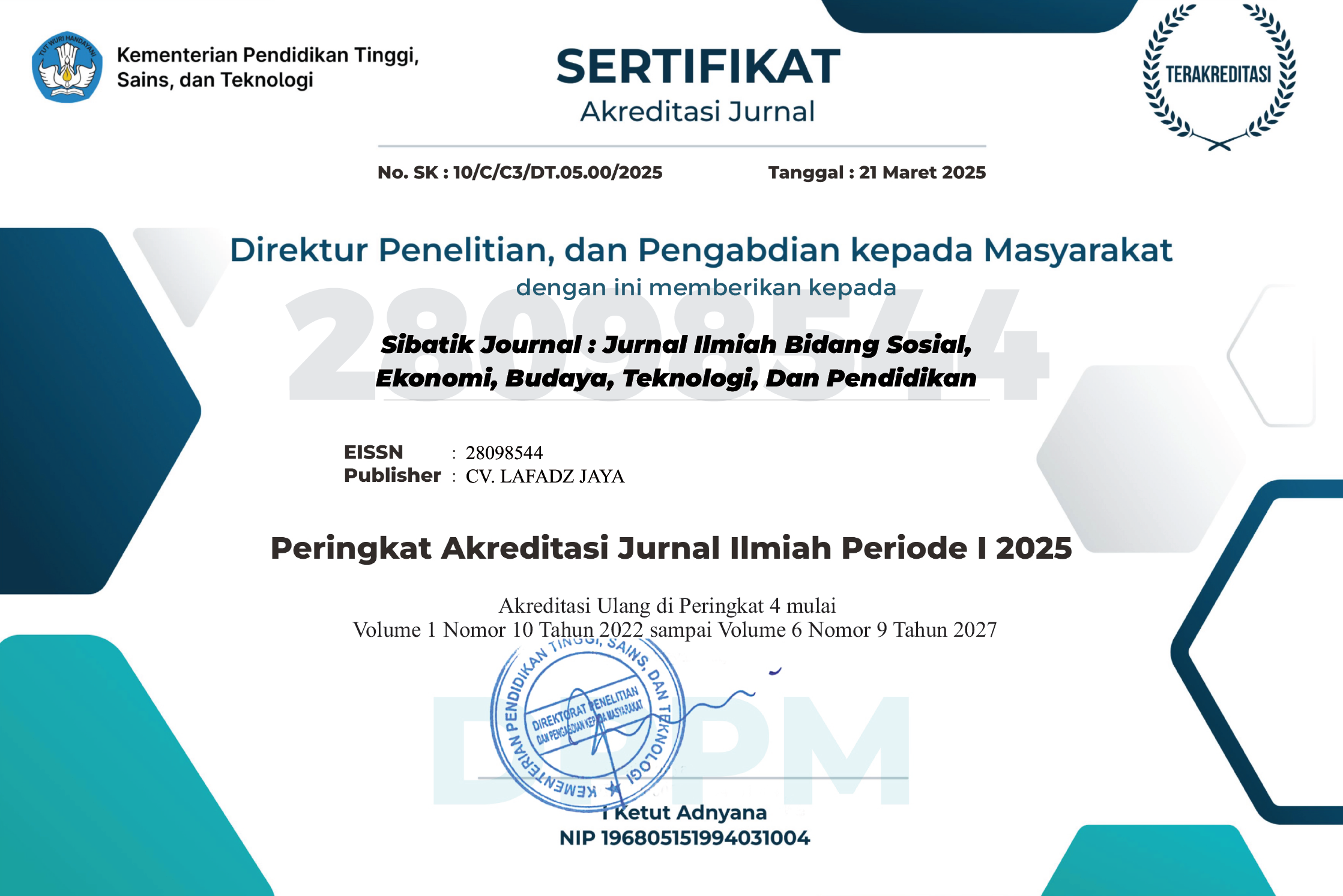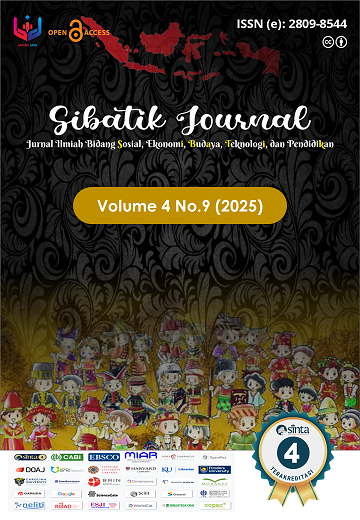ANALISIS PENGARUH EKSPOR MIGAS, PMDN, PDB TERHADAP TINGKAT KEMISKINAN DI INDONESIA
Main Article Content
‘Asy'fa Awwalina Alfi Ainurrahmi
Tutik
This study analyzes the effect of oil and gas exports, Domestic Investment (PMDN), and Gross Domestic Product (GDP) on poverty levels in Indonesia during the period 1998–2023 using the Error Correction Model (ECM) approach. The objective is to examine both the short-term and long-term relationships between these macroeconomic variables and their impact on poverty reduction. The results show that all three variables have a negative and significant effect on poverty levels. Oil and gas exports reduce poverty by 0.11% in the short term and 0.19% in the long term. PMDN contributes to a 0.06% decrease in poverty in the short term and 0.10% in the long term. Meanwhile, GDP helps reduce poverty by 0.11% in the short term and 0.17% in the long term. The adjusted R² value of 97.21% indicates that the model explains the variation in poverty levels very well. These findings affirm that increasing oil and gas exports, domestic investment, and economic growth are effective strategies for poverty alleviation. Therefore, the government should strengthen and sustain economic policies supporting these three sectors to ensure equitable and sustainable poverty reduction.
Adhista, M. 2022. “Analisis Ekspor, Impor, dan Jumlah Uang Beredar (M2) Terhadap Nilai Tukar Rupiah.” Jurnal Ilmiah Ekonomi Pembangunan, 73–92.
Agboola, E., R. Chowdhury, and B. Yang. 2024. “Oil Price Fluctuations and Their Impact on Oil-Exporting Emerging Economies.” Economic Modelling 132. https://doi.org/10.1016/j.econmod.2024.106665.
Arsyad, Lincolin. 2010. Ekonomi Pembangunan. Yogyakarta: UPP STIM YKPN.
Arteaga, J. C., M. L. Cardozo, and M. J. T. Diniz. 2020. “Exports to China and Economic Growth in Latin America, Unequal Effects within the Region.” International Economics 164: 1–17. https://doi.org/10.1016/j.inteco.2020.06.003.
Arza, F., and M. Murtala. 2021. “Pengaruh Ekspor Hasil Minyak dan Impor Minyak Bumi terhadap Pertumbuhan Ekonomi di Indonesia.” Jurnal Ekonomika Indonesia 10(1): 23–32.
Badan Pusat Statistik. 2015. “Jumlah Penduduk Miskin, Persentase Penduduk Miskin dan Garis Kemiskinan.” Diakses dari https://www.bps.go.id/linkTabelStatis/view/id/1494.
Badan Pusat Statistik. 2023. Profil Kemiskinan di Indonesia Maret 2023. Diakses 17 Juli 2023. https://www.bps.go.id/id/pressrelease/2023/07/17/2016/profil-kemiskinan-di-indonesia-maret-2023.html.
Bist, A. S. 2023. “The Importance of Building a Digital Business Startup in College.” Startupreneur Business Digital (SABDA Journal) 2(1): 31–42.
Fadhillah, A., A. Arintoko, and K. Kamio. 2021. “Effect of Exports, Government Expenditure and Inflation on Indonesia Poverty (2000–2019).” Media Ekonomi 21(1): 43. https://doi.org/10.30595/medek.v21i1.11780.
Habib, M. A. F. 2021. “Kajian Teoritis Pemberdayaan Masyarakat dan Ekonomi Kreatif.” Ar Rehla 1(2): 82–110.
Indayani, S., and B. Hartono. 2020. “Analisis Pengangguran dan Pertumbuhan Ekonomi sebagai Akibat Pandemi Covid-19.” Perspektif: Jurnal Ekonomi dan Manajemen Akademi Bina Sarana Informatika 18(2): 201–208.
Kasmir. 2019. Manajemen Sumber Daya Manusia. Depok: Rajawali Pers.
Koch, P. 2021. “Economic Complexity and Growth: Can Value-Added Exports Better Explain the Link?” Economics Letters 198. https://doi.org/10.1016/j.econlet.2020.109682.
Lestari, R. I., B. Wardono, M. Handajani, S. Supari, H. Juniati, M. T. D. Sunarno, and E. Prayogi. 2025. “The Interplay of Road Infrastructure and Regional Finance in Driving Economic Growth: Insights from East Kalimantan.” Journal of Open Innovation: Technology, Market, and Complexity 11(1). https://doi.org/10.1016/j.joitmc.2024.100444.
Luqiana Putri, T., and R. Eviana Hutabarat. 2024. “Analisis Pengaruh Pengangguran, Penanaman Modal Dalam Negeri, dan Upah Minimum Provinsi terhadap Kemiskinan di Jawa Timur.” Jurnal Riset Pendidikan Ekonomi 9(1): 66–77. https://doi.org/10.21067/jrpe.v9i1.9842.
Maritza Arumsari, R. A. Zakaria, and D. Rahajuni. 2025. “Pengaruh Ekspor Migas terhadap Pertumbuhan Ekonomi di Asia Tenggara.” Ssio e-Kons.
Meka’a, C. B., S. R. Fotso, and B. R. Guemdjo Kamdem. 2024. “Investments in Basic Public Infrastructure and Their Effects on Economic Growth in a Developing Country: The Case of Cameroon.” Heliyon 10(4). https://doi.org/10.1016/j.heliyon.2024.e26504.
Murshed, M. 2022. “The Impacts of Fuel Exports on Sustainable Economic Growth: The Importance of Controlling Environmental Pollution in Saudi Arabia.” Energy Reports 8: 13708–13722. https://doi.org/10.1016/j.egyr.2022.09.186.
Mustafa, M., and E. Aulia. 2023. “Analisis Pemanfaatan Dana Desa Bumi Sari Kabupaten Nagan Raya Berdasarkan Konsep Negara Kesejahteraan.” MAQASIDI: Jurnal Syariah dan Hukum: 54–67.
Rahman, M. M., R. Nepal, and K. Alam. 2021. “Impacts of Human Capital, Exports, Economic Growth and Energy Consumption on CO2 Emissions of a Cross-Sectionally Dependent Panel.” Environmental Science and Policy 121: 24–36. https://doi.org/10.1016/j.envsci.2021.03.017.
Salsabila, D. R. N. 2021. “Analisis Pengaruh Ekspor Migas dan Non Migas terhadap Pertumbuhan Ekonomi Indonesia.” Jurnal Akuntansi dan Manajemen 18(01): 1–8.
Sebastio, A. J., T. Nurgiyanti, et al. 2023. “Upaya Sekolah Ekspor dalam Meningkatkan Ekspor Indonesia melalui Pemberdayaan UMKM Tahun 2022.” SEIKAT: Jurnal Ilmu Sosial, Politik dan Hukum 2(3): 211–217.
S, S. W., and H. S. Soegoto. 2022. “Peran PMDN dan PMA terhadap Penurunan Angka Kemiskinan di Indonesia.” JURISMA: Jurnal Riset Bisnis & Manajemen 12(1): 1–15. https://doi.org/10.34010/jurisma.v12i1.5838.
Sujianto, Agus Eko, et al. 2024. “Analisis Penentuan Produk Domestik Bruto atau GDP (2 Sektor).” Musytari: Jurnal Manajemen, Akuntansi, dan Ekonomi 5(8): 1–10. https://doi.org/10.8734/musytari.v5i8.3378.
Tamba, A. V., M. L. Purba, and J. Sihotang. 2023. “Analisis Pengaruh Pengeluaran Pemerintah, Penanaman Modal Dalam Negeri, dan Penanaman Modal Asing terhadap Produk Domestik Bruto di Indonesia Periode 2000–2020.” Jurnal KAFEBIS 1(1): 1–10. https://doi.org/10.51622/kafebis.v1i1.2008.
Todaro, M. P., and S. C. Smith. 2020. Economic Development. London: Pearson.
Varghese, A. M., and R. P. Pradhan. 2025. “Transportation Infrastructure and Economic Growth: Does There Exist Causality and Spillover?” Transportation Research Procedia 82: 2618–2632. https://doi.org/10.1016/j.trpro.2024.12.208.
Wang, Z., D. Peng, Q. Kong, and F. Tan. 2025. “Digital Infrastructure and Economic Growth: Evidence from Corporate Investment Efficiency.” International Review of Economics and Finance 98. https://doi.org/10.1016/j.iref.2025.103854.
Wati, H. W. 2015. “Analisi Pengaruh Belanja Modal Daerah, Investasi, dan Indeks Pembangunan Manusia (IPM) terhadap Kemiskinan di Indonesia Tahun 2009–2013.” Jurnal Ilmiah Mahasiswa FEB Universitas Brawijaya 3.
Yusrya, N. 2023. “Analisis Pengaruh PDB, Jumlah Penduduk dan Pengangguran terhadap Kemiskinan di Indonesia Tahun 1997–2020.” SENTRI: Jurnal Riset Ilmiah 2(4): 1017–1028. https://doi.org/10.55681/sentri.v2i4.699.
Zaman, B. 2019. “Urgensi Pendidikan Karakter yang Sesuai dengan Falsafah Bangsa Indonesia.” Al Ghazali 2(1): 16–31. https://ejournal.stainupwr.ac.id/index.php/al_ghzali/article/view/101.

























